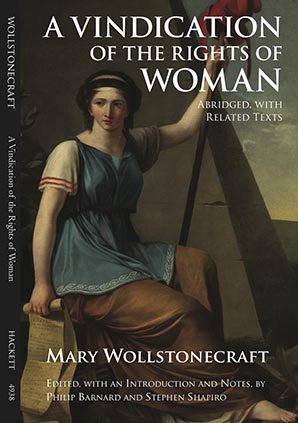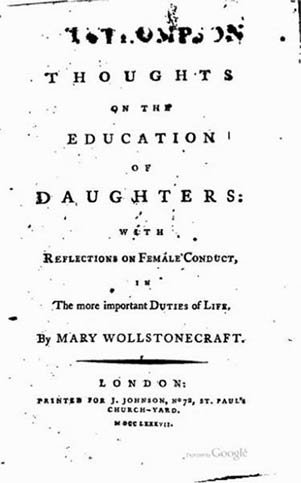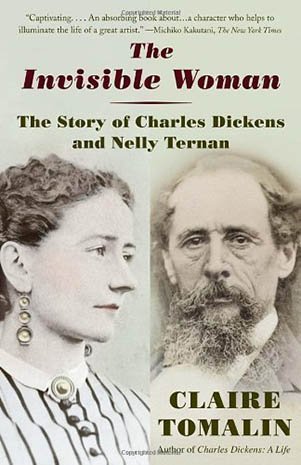Mary Wollstonecraft: A Hyena in petticoats, or was she just misunderstood?
Last year, I wrote an article for Headstuff about one of Mary Wollstonecraft Shelley’s books, her only children’s novel Maurice. In so doing, I realised that perhaps I should have begun with her mother Mary Wollstonecraft (1759-1795) since Shelley’s book contained intriguing biographical hints. It may seem counter intuitive to go backwards now and talk about her mother, but I am going to do just that in this article. For this article, I have recently been re-reading Claire Tomalin’s The Life and Death of Mary Wollstonecraft (1974, Weidenfeld and Nicholson; reprinted revised and expanded in 1992, Penguin Books). Penguin brought out smartly jacketed reprints of several of Claire Tomalin’s titles, including this one, in 2012.

Mary Wollstonecraft is one of Tomalin’s very readable and meticulously researched biographies. I have read two more of her books, biographies of women who occupied unconventional places in society as actresses and later mistresses of prominent men. I will talk a little about these books at the end of this piece for anyone interested in exploring further. First, I want to introduce Mary Wollstonecraft, feminist pioneer and the mother of the woman who created the Gothic horror of Frankenstein. I have drawn my piece from Claire Tomalin’s work since I think her book provides an excellent place to start if you don’t know much about Wollstonecraft or early feminism. I will give a potted history of Wollstonecraft’s early life and career up to her ‘breakthrough’ moment with Vindication of the Rights of Woman in 1792. I have also recently covered a different angle on my own blog if you would like to read more.
Mary Wollstonecraft was born in Spitalfields, London to Edward and Elizabeth Wollstonecraft (née Dixon). The Wollstonecraft family originated in Lancashire, moving south at the beginning of the eighteenth century when Edward’s father (also named Edward) began manufacturing in the Spitalfields area. Mary’s mother was an Irishwoman who originally came from Ballyshannon, where her family earned a good living in the wine trade. The couple had five surviving children, Mary being the second child and the eldest daughter. Edward senior did well for himself and the family prospered. However, his son lacked the same drive and during Mary’s childhood, the Wollstonecrafts started to slide down the social scale almost as soon as they had climbed up it a little way. Consequently, the family moved around a great deal, so Mary’s childhood seems to have been quite unsettled and precarious.
Mary Wollstonecraft grew up to be a formidable woman, far ahead of and often out of step with the social attitudes of her time. From an early age, Mary seemed to have raged against her place in the world, and within her own family. Claire Tomalin comments on Mary’s ‘sense of grievance’. The young Mary was:
“…sharp in manner and often angry in appearance: her eyes bulged, the corners of her mouth turned down. From a very early age she nourished the sense that she was unappreciated and denied affection that was her due.”
Edward Wollstonecraft tended towards drinking and violence to the extent that Mary had at times needed to protect her mother. That clearly would have affected her relationship with both of her parents. Furthermore, due to Edward’s attitudes towards education for women, the quality of schooling for Mary and her two younger sisters was barely adequate whereas their elder brother Ned attended a grammar school and went into law. Ned was also later to inherit a portion of his grandfather’s estate while the three girls received nothing.
Tomalin writes, ‘How much they [her parents] were really to blame for making her unhappy is hard to say; apart from the drunken episodes they seem to have been cool rather than cruel, too preoccupied with their own interests and troubles to give Mary what she wanted of them, unable to fill the roles she wished to see them in, and unappreciative of her efforts to impress them.’
After one of the family moves, they settled in the Hoxton area of London. Here the sixteen-year-old Mary made the acquaintance of a retired clergyman and his wife, Mr and Mrs Clare, who were to be important in supplementing her patchy education. Claire Tomalin speculates what they would have encouraged her to read. Milton, Shakespeare and Johnson perhaps. While at the Clares, Mary met Frances (Fanny) Blood who was also a protégé, but a couple of years older. Fanny made a great impression on Mary and they quickly became friends and kept in touch when Fanny returned to her parents. What emotional bonds Mary failed to find within her own family (her relationship with her younger sisters was often fraught) she found in passionate female friendships such as with Fanny.
If we leap forward a few years to 1784, after Elizabeth Wollstonecraft’s death, Mary was attempting to earn a living by teaching. She had managed to borrow money (Tomalin suggests from Mr and Mrs Claire) to set up a small school in a house in Newington Green, a leafy district of London. Joined in this venture were Fanny Blood and Mary’s sisters Eliza and Everina. None of the young women were particularly well educated but they could teach reading, writing, some drawing, and sewing skills. At that time, Mary became involved in the Dissenting circles that had grown up in the area. Her introduction was through Dr Richard Price, the Dissenting Chapel minister well known to radical intellectuals, reformers and scientists of the day. He corresponded internationally, with the Marquis de Condorcet in France (an advocate of female suffrage) and with Benjamin Franklin and Thomas Jefferson in America. Taken together with his local political and reforming connections, he was an ideal person to begin the process of stimulating Wollstonecraft’s yet unfocussed intellect and energies.

I mentioned above Mary’s sense of grievance. Undoubtedly, this anger was one of the spurs that drove Mary’s ambitions onwards. It thus helped to pave the way for Vindication of the Rights of Woman. She had seen enough of how society’s inequalities had an impact on women and their lives, and had seen it in her own family. Her first foray into print was Thoughts on the Education of Daughters in 1786. No doubt, some of the inspiration for this had come when Mary spent time as governess to an Irish family, the Kingsboroughs of Mitchelstown, where she built a good relationship with one of the daughters, Margaret (see my earlier piece). Mary had written that, women’s education meant for them ‘few are the modes of earning a subsistence, and those very humiliating’. She wrote Vindication in just six weeks of sustained work, in response to Thomas Paine’s Rights of Man. As well as Thoughts on the Education of Daughters, she had already published some fiction and reviews with Joseph Johnson of St Paul’s Churchyard, a radical publisher who encouraged and financially supported her career. The feminist polemic of Vindication made Mary Wollstonecraft famous almost overnight in political and philosophical circles. Contemporary critics largely reviewed Wollstonecraft’s work favourably, but what did Vindication actually have to say about women?
I have never tackled the book (long on my virtual ‘to be read’ pile) but Tomalin discusses Vindication and the reaction to it in a chapter of its own. She sums up the book’s philosophy on women in this paragraph, (at the same time pointing out the book’s technical faults).
‘The Vindication is a book without any logical structure: it is more in the nature of an extravaganza. What it lack in method it makes up for in élan, and it is better to dip into than read though at a sitting. The theme is this: that women are human beings before they are sexual beings, that mind has no sex, and that society is wasting its assets if it retains women in the role of convenient domestic slaves and ‘alluring mistresses’, denies them economic independence and encourages them to be docile and attentive to their looks to the exclusion of all else’.
Mary Wollstonecraft’s views on women seem to me to be very forthright for a young, sexually inexperienced woman of the time and therefore surprisingly modern. To Mary Wollstonecraft we owe the damning expression describing marriage as ‘legalised prostitution’. She also discussed the issues surrounding the oldest profession, which was a brave thing for her to have done at that time. Respectable women were not supposed to know about any other sort. Mary wrote that prostitutes were not bad women, but merely ignorant and lacking in other opportunities.
Claire Tomalin’s discussion about Mary Wollstonecraft’s ideas also introduces feminist thinking (and its detractors) of the time. It is worth noting that there were certainly male writers who supported the idea of votes for women and of better education and a different role for women in society. Jeremy Bentham, in 1788, was able to conclude that there was no logical reason not to give women a vote, after he had carefully considered and then demolished the objections. At the same time, there were politically active Dissenting women such as Ann Jebb (1735- 1812) who, while supporting universal male suffrage were not interested in extending it to women. We have Horace Walpole to thank for coining the expression ‘hyena in petticoats’ to describe Mary, as well as ‘philosophising serpent’, which clearly refers to the much maligned Eve. I cannot help wondering how long it took him to come up with those not very helpful contributions to the debate.
Mary Wollstonecraft packed a great deal of experience into her life so I hope that I have written enough to pique your curiosity to discover more. I do intend to read her writings, on the basis that would be better late than never. As the subject of feminism continues to be hotly debated and its proposed banning is even the rallying cry of a new political movement in the UK, now seems as good time as any to read the work of a very brave woman.
And just to close with: two more unconventional women …

At the beginning of this article I said that I would return to Claire Tomalin’s other biographies, and so here are a couple of books that I would highly recommend. The Invisible Woman: The story of Nelly Ternan and Charles Dickens and Mrs Jordan’s Profession. I particularly valued Nelly Ternan’s story, as there was a real prospect of her history being lost forever amongst the Dickens mythology. Tomalin disentangled the truth from the careful web of deceit surrounding Dickens’ intensely guarded private life. The Ternan family were well-established theatricals, who met Dickens when they became involved in working on a production of one of his pieces. Very few people ever knew about Dickens’ subsequent relationship with the young actress, as Dickens was still married at the time and his public persona had to be above reproach.
Mrs Jordan’s Profession is about the acclaimed comic actress Dorothy (Dora) Jordan (1761-1815) who later became mistress to William, Duke of Clarence (1765-1837). She bore him ten children and they were a very happy family until government ministers forced the duke to end his relationship and marry respectably. Poor Dorothy Jordan paid the price for the fact that the future of the British crown was at stake after the death of the Prince of Wales’ only daughter in childbirth. She had a fascinating life and a successful stage career but her alliance with a future king meant that her story has been pushed into the background.
Both biographies give you some idea of how precarious life on the stage was for women in eighteenth and nineteenth century England. Neither fish nor fowl, their place away from the theatrical world was ambiguous. Both Nelly Ternan and Dorothy Jordan had to live their lives around society’s expectations of ‘respectable’ women and both suffered because of these expectations.
Featured image source: queerreferat.de

